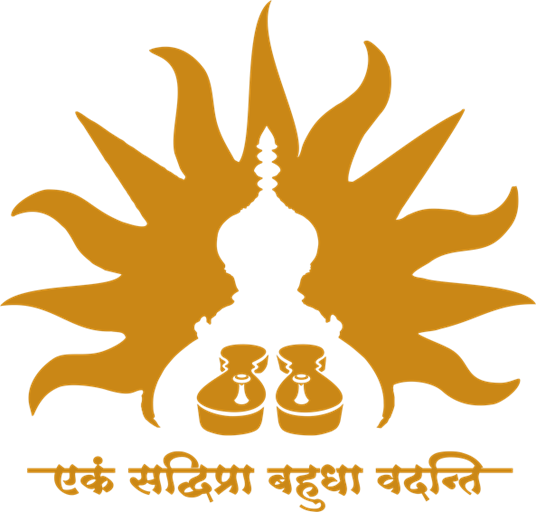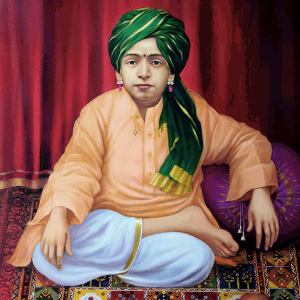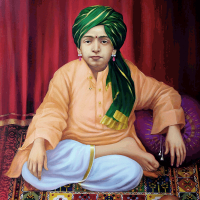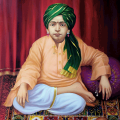Shri Manohar Manik Prabhu, the immediate successor to the holy Peetha of Shri Prabhu, was one among the great Yogis of India’s enviable age-long spiritual tradition, who, within the very short period of his temporal life, reached the pinnacle of spiritual accomplishment, which many find challenging to achieve even in repeated cycles of births and re-births. Born on 7th September 1858, he was the elder son of Prabhu’s younger brother, Shri Narsimha Tatya Maharaj. He adorned the holy seat of Shri Prabhu at the tender age of seven and attained Sanjivani Maha-Samadhi while he was but nineteen years of age.
The Maha-Samadhi of Prabhu was a great loss to the followers of the Sampradaya, who sorely missed his divine physical presence. But their sorrow would vanish when they beheld the supremely blissful Baala-Yogi Shri Manohar Prabhu, who was verily a reflection of Prabhu, albeit in a newer form.
When Shri Manohar Manik Prabhu took over the charge of Shri Manik Prabhu Samsthan, he seemed to have been fully energised with the divine grace of Prabhu to cope with the responsibility assigned to him. With the devoted followers of the Sampradaya, he delved into the spiritual and temporal matters pertaining to the Samsthan. He organised the financial affairs of the Samsthan in such a manner that the spiritual activities of the Samsthan, as well as its administrative matters, continued as smoothly as before.
Shri Manohar Prabhu felt that it was one of his prime responsibilities to tackle the heavy burden of debt that worried every well-wisher of the Samsthan. One day, he instructed Bappacharya to make a list of all the creditors and call them for a meeting the next day. It was a bit perplexing to Bappacharya that Shri Maharaj was calling all the creditors when there was no money in the Samsthan to pay them. However, he carried out the instructions of his Guru. The next day, as soon as the meeting started, Kishan Gir, a wealthy businessman from Kalyan and the biggest creditor who had lent ten thousand rupees to Prabhu, said, “I declare that Prabhu and his Samsthan owe nothing to me. All the wealth, running into lakhs, that I have today, is solely due to Shri Prabhu’s blessings. How can an ordinary soul like me claim to be a creditor to the Lord of the Universe?” In this way, he requested that his name be struck from the list. Another big creditor from Humnabad, Kalappa Vasgi also surrendered his claim on the Samsthan. Motivated by these magnanimous gestures, the rest of the creditors also followed suit.
All the devotees who had witnessed the proceedings were dumbstruck and in awe of the manner in which this small child of seven years, had so easily rid the Samsthan of its burden of debt. Everyone was convinced that Shri Manohar Prabhu was truly a worthy successor of Manik Prabhu.
Shri Manohar Manik Prabhu was very particular and concerned that all the rituals and festivities conducted during Shri Prabhu’s time be continued uninterruptedly. When he ascended the gaadi, he was hardly seven years of age, but it was soon apparent to all that he had already traversed miles on the spiritual path and was indeed a pure realised Soul.
All those who met him marvelled at his in-depth understanding of the Vedas and Upanishads. He was not only a great Yogi but also an exceptional poet. He composed many bhajans and abhangas in Marathi, Hindi, Urdu, and Kannada, which are full of devotion to Prabhu and reflect his deep philosophical wisdom. During the twelve years that he graced Shri Prabhu’s gaadi, he composed a mass of literature codifying the pooja, abhishekh, upasana and other rituals still prevalent in Maniknagar. He composed many stotras, shlokas, and ashtakas in Sanskrit in praise of Prabhu, which acclaimed scholars regarded as literary masterpieces.
The magnificent temple of Prabhu at Maniknagar, built in black granite and with its unique architectural splendour, stands as a towering testament to the vision of Shri Manohar Manik Prabhu Maharaj. No one can even imagine that a seven-year-old boy envisioned, planned and executed such a grand architectural marvel. The construction work took twelve years, and the architect was Sanataram Dada Gavandi.
Manohar Prabhu was a great Yogi and lived the life of a pure, realised soul. His constant communion with the Supreme Self made him yearn to merge his Self with Prabhu’s divine feet. Even as he was designing the temple over the Samadhi of Shri Manik Prabhu Maharaj, he was also contemplating creating a place where he could reside for eternity in the blissful contemplation of his Sadguru. While going around an underground cellar behind the site of Prabhu’s temple, he once exclaimed, “How beautiful and quiet a place is this? A fit place for a Yogi to sit and meditate for all the aeons to come.” However, no one present then realised that Manohar Prabhu had, in his mind, envisaged the spot to be his permanent abode in time to come.
Once Shri Manik Prabhu’s Temple was complete, the rituals of Shri Prabhu’s routine worship firmly established, and he was satisfied that the affairs of the Samsthan were well organised, Manohar Prabhu felt that his earthly mission had been accomplished and decided to follow in the footsteps of his Sadguru and enter Sanjeevani Maha-Samadhi. On 28th October 1877, after obtaining permission from his mother, Shri Manohar Prabhu took the Sanyasa Deeksha according to the scriptures. After that, he blessed his younger brother, Shri Martand Prabhu, with Mantra-Upadesha and Prasada, thus ensuring the continuity of the Guru Parampara. Sitting in one of the arches in the cellar behind Shri Prabhu’s temple, Manohar Prabhu attained Sanjeevani Maha-Samadhi, becoming one with his beloved Sadguru.




